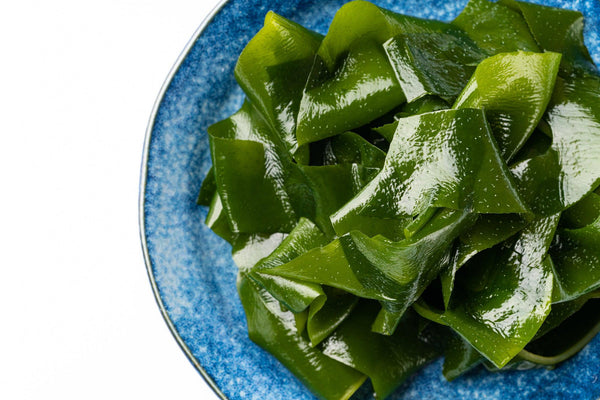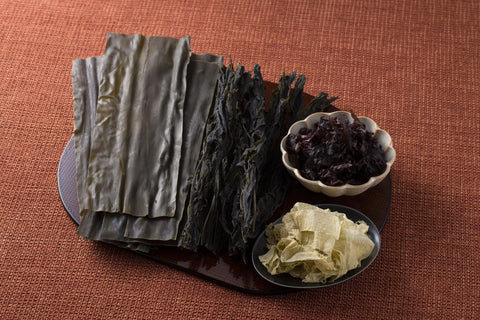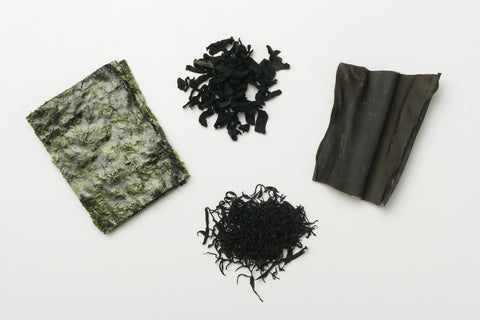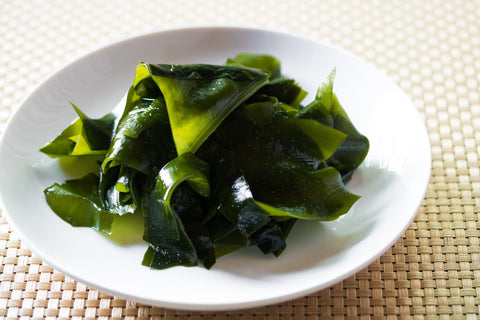
Jump to:
Wakame, along with Nori and Kombu, is one of the three main types of Japanese seaweed (although an honorary mention should also go to Hijiki and Mozuku). Sometimes referred to as “sesame seaweed” or “sea lettuce”, Wakame is the dark-green edible type of seaweed often found in miso soup, salads, and vinegary side dishes.
In this article, we shall take a closer look at what Wakame is, including how it gets from the sea to your table, and consider its health benefits (including possible risks). We shall also compare it to other edible seaweed, such as Kombu and Nori, look at how to prepare Wakame, how it should be stored, and round off by looking at options for purchasing Wakame.
What Is Wakame?

Wakame is brown algae belonging to the kelp family, which grows in the subtidal zone throughout Japan from winter to spring. It has a sweet, but mild taste, and a supple yet crisp texture, being both crunchy and chewy at the same time.
Wakame consists of the root, the mekabu (or holdfast), the stem, and the leaf parts, with the leaf part generally considered edible. The mekabu part may be used in vinegared dishes, and the stem is processed into Tsukudani (boiled in soy sauce and vinegar.)
The mild taste of Wakame means that it is easy to introduce to a wide range of dishes and provides a nutritionally delicious punch without overpowering the flavor of the dish in question. Before we explore its nutritional benefits in detail, let us investigate how Wakame gets to our dining table in the first place.
Wakame: From Ocean To Table

Wakame grows naturally in the wild and may be picked directly by ama divers, but cultivated Wakame is the most widely distributed type. The cultivation method involves releasing migratory spores from the Wakame's mekabu (sporophyte) and attaching them to a seedling collector. Mekabu sporophytes may release their migratory spores when the seawater temperature exceeds 10°C (June to July in the Sanriku region), but these are only reliably released when the water temperature reaches 14°C or higher. Usually, a plastic, wooden, bamboo, iron wire, or other square frame (50-100 cm) is used as a seedling collector to wrap the seed threads After the seedlings have grown to about 1.2 cm in size, they are wrapped around a rope and grown in the sea, where they are harvested.
Although there are different ways of achieving this, harvesting of cultured Wakame is usually done by a special boat that reels up the rope, reaps it over a fish hold, drops the mekabu or roots from the rope, and reels the rope with a capstan at the stern of the boat.
There are several methods for processing Wakame, depending on whether it’s fresh or dried. In both cases, the Wakame is typically first blanched or boiled. Then, fresh Wakame, either in raw, salted, or marinated form is packaged. The packing of dried Wakame is performed after being sun-dried, oven-dried, or dehydrated, before being distributed to warehouses, restaurants, markets or supermarkets, etc., and then making its way to your meal table.
Is Wakame Good For You?

Despite some caveats regarding over-consumption, Wakame can be said to be an extremely healthy food.
Wakame is a food that is rich in minerals such as calcium, magnesium, and iodine, as well as dietary fiber, vitamin K, β-carotene, and other nutrients.
The nutrients in Wakame can be expected to have the following effects.
(i) Magnesium: formation of teeth and bones, normal functioning of enzymes, aids metabolism, and lowers blood pressure by dilating blood vessels
Iodine: promotes metabolism, moisturizes hair and skin by synthesizing thyroid hormones, and aids children's growth
(ii) Calcium: strengthens teeth and bones
Dietary fiber: regulates the intestinal environment, prevents obesity and high blood pressure, and lowers blood sugar and cholesterol levels. In addition, recent studies have shown that fucoidan, a component of dietary fiber in Wakame, has the ability to eliminate H. pylori bacteria, which is one of the causes of stomach ulcers and stomach cancer.
(iii) Alginic acid: regulates the intestinal environment, prevents obesity and high blood pressure
(iv) Potassium: Relieves constipation by removing cholesterol from the intestines, prevents high blood pressure by maintaining the body's water balance, and reduces swelling caused by excess salt in the body
(v) β-carotene: This antioxidant has anti-aging effects.
As always, however, you can get too much of a good thing. Whereas the iodine in Wakame is good for maintaining thyroid function, over-consumption can have the opposite effect of disrupting thyroid function, and lead to symptoms such as fever, stomach pain, nausea, and diarrhea. Wakame also contains a significant amount of sodium, and too much can affect blood pressure levels.
The bottom line is that Wakame taken in moderation is extremely healthy and can provide a host of vital nutrients but should be included only as part of a balanced diet, and not over-consumed.
Wakame vs Kombu vs Nori
So how does Wakame compare to other popular types of seaweed in Japan such as Kombu and Nori?
Wakame vs Kombu

Whereas Wakame is often eaten uncooked after being rehydrated, Kombu is generally enjoyed cooked in winter warmer dishes like Oden, as well as miso soup and, importantly, as a primary ingredient providing the Umami in Dashi, the broth that forms the basis of hotpots like Shabu-Shabu. Compared to Wakame, it has a slightly rubbery texture when cooked.
Wakame vs Nori

Nori is a red alga, instead of a brown alga like Wakame. Whereas Wakame is usually eaten in rehydrated form, Nori is always eaten dried, either as Nori sheets wrapping Sushi rolls and Onigiri rice balls, and strips and flakes used as a topping for salads, soups, or with Tororo, a sticky dish made from grated yam. It has a stronger, saltier taste than Wakame, which tends to be sweeter.
How To Prepare Wakame?
If you buy dried, rather than fresh, Wakame, you will need to rehydrate it before use. You can do this in the following way:
1) Place the dried Wakame in a bowl.
2) Cover the Wakame with water.
3) Add more water if necessary to ensure it is fully submerged.
4) Soak until the Wakame softens. This will take approximately 10 minutes.
5) Drain the water and place the Wakame on kitchen paper or in a sieve to remove the excess moisture.
Common Ways Of Using Wakame?

When combined with fresh vegetables and a tasty dressing, Wakame adds a crunchy texture and fresh flavor to salads. It tends to be added plentifully to miso soups and more sparingly (for aesthetic reasons) in O-Sui (clear soup). You can also find it as a side dish when eating Sashimi, and it is a common ingredient combined with cucumber in Sunomono, a healthy and tasty vinegary dish. You can find the recipe here if you would like to try making it. Finally, it is simmered with vegetables in Nimono.
How To Store Wakame
In the case of dried Wakame that has not yet been rehydrated, you can store it in a cool, dry, place for a long period, up to a year. However, if you refrigerate Wakame after it has been rehydrated, the storage period is much shorter, and you should use it up within 3-4 days. If you need to keep it longer, you will need to freeze it, in which case you can keep it for around a year.
The method of storing raw Wakame is the same for both refrigeration and freezing. The raw Wakame should be tightly wrapped in plastic wrap, put in a storage bag, and then placed in the refrigerator or freezer. It can be stored for approximately 2-3 days when refrigerated, and 1 to 2 months when freezing.
Where To Buy Wakame?
So, if you are convinced of the nutritional properties of Wakame, how can you go about introducing it into your diet?
Well, you can certainly purchase Wakame in all of its forms at most supermarkets, but the Japanese Taste website is also a convenient place to go to start your Wakame journey. If you are looking for some dried Wakame to use in your cooking, then look no further than this 100g pack from Daihoku or, if you would like to start with something smaller, this one from Izuri fits the bill perfectly (also comes in a pack of three.)
If you want to save time by combining dried Wakame and vegetables in a mix, try this one from Daihoku. There are some instant options for Miso soup with Wakame too, from Marukome and Matsuo, which come in packs of three, or this pack from Nagatanien, which contains enough for approximately 100 servings.
You can also find this salad which contains five types of seaweed including Wakame and Wakame stem, as well as this spicy Wakame Chinese-style snack.
Wakame – The Healthy And Versatile Brown Algae

As discussed in this post, Wakame is a highly versatile food that packs a healthy punch. Introducing it to your cooking, whether in salads, soups, pickled, or vinegary dishes, is a reliable way of ensuring you get access to a full range of vitamins and minerals without too much effort expended on your behalf. For more information about Wakame and other types of Japanese seaweed, we recommend you check out this deep dive article.
Are you a fan of Wakame? If so, what is your favorite Wakame-based dish? Let us know in the comments.


0 comments